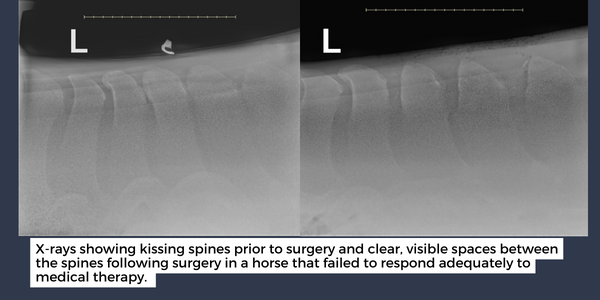What is kissing spines and why has it suddenly become more common?
Kissing spines or more correctly termed ‘impinging dorsal spinous processes’ (IDSPs) is where there is over-crowding of the summits of the 18 spines that the horse has, usually in the saddle region of the spine. This leads to bone friction and pain which spreads along the muscles either side of the spine. In our years of experience of dealing with this disorder, by far the most common clinical signs are (in order):
- Bucking
- Being ‘Cold-backed’ on mounting
- Hunching or arching of the spine
- Sudden shooting/scurrying under saddle particularly on mounting
- Bolting
Yes, some young (and old!) horses will buck when they are excited, these horses usually have their ears pricked and they are ready to go!! Horses who buck due to pain will have their ears pinned back and they are not ready to go, they just want to get rid of the pain (unfortunately that’s usually the rider on board!).
The problem we have in diagnosing this condition is that many horses will have kissing spines on X-rays of their spine, in fact up to 86% of thoroughbred horses will have x-rays consistent with IDSPs! That does not mean that they are all painful! To determine whether or not the x-ray findings are causing discomfort relies on 3 methods of diagnosis (in order of our preference!):
- Medication of the spine with steroids (potent anti-inflammatory drugs) which lasts several weeks in this region in severe cases, so you can tell if your horse feels better over this prolonged period of time.
- Infiltration of the spine with local anaesthetic and seeing if the clinical signs resolve when the horse is re-evaluated ridden.
- A ‘bute’ trial, whereby we administer systemic anti-inflammatory drugs to see if the clinical signs improve.
Only then can we be sure if the X-ray findings are consistent with pain in the horse. So your horse is diagnosed with kissing spines, what can we do? Is it hopeless? NO, in fact, this condition can be treated fairly successfully in most cases either with conservative management and altered training techniques, including physiotherapy or with different surgical methods. If your horse is suffering with kissing spines, we are equipped to help you every step of the way with your journey back into the saddle.
And in answer to the original question, IDSPs is NOT more common than it was years ago…….we just have X-ray machines that are capable of seeing the spine now. We are also more aware than ever that our horses are generally not a naughty bunch, and are often just asking for our help because something hurts!

